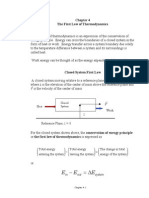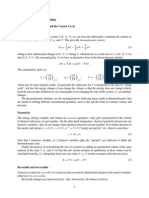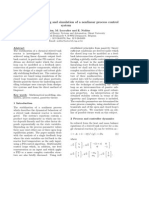5.3 Macroscopic Energy Balance: in Out
5.3 Macroscopic Energy Balance: in Out
Uploaded by
masyuki1979Copyright:
Available Formats
5.3 Macroscopic Energy Balance: in Out
5.3 Macroscopic Energy Balance: in Out
Uploaded by
masyuki1979Original Description:
Original Title
Copyright
Available Formats
Share this document
Did you find this document useful?
Is this content inappropriate?
Copyright:
Available Formats
5.3 Macroscopic Energy Balance: in Out
5.3 Macroscopic Energy Balance: in Out
Uploaded by
masyuki1979Copyright:
Available Formats
Chapter 5
5.3 Macroscopic Energy Balance
The general energy balance equation has the form
,
_
Energy of
on Accumulati
=
,
_
Energy of
Input
,
_
Energy of
Output
+
,
_
System to
added Heat
1
]
1
System by
done Work
Let E
sys
be the total energy (internal + kinetic + potential) of a system,
in
m
be the mass flow
rate of the system input stream, and
out
m
be the mass flow rates of the system output stream,
then
dt
d
( )
sys p sys k sys
E E U
, ,
+ +
=
in
m
,
_
+ +
in
in
in
gz
V
u
2
2
out
m
,
_
+ +
out
out
out
gz
V
u
2
2
+ Q
(5.3-1)
where
U
sys
= system internal energy
E
k,sys
= system kinetic energy
E
p,sys
= system potential energy
in
u
,
out
u
= internal energies per unit mass of the system inlet and outlet streams
in
V
,
out
V
= average velocity of the system inlet and outlet streams
Q
= rate of heat added to the system
W
= rate of work done by the system
The net rate of work done by the system can be written as
W
=
s
W
+
f
W
where
s
W
= rate of shaft work = rate of work done by the system through a mechanical
device (e.g., a pump motor)
f
W
= rate of flow work = rate of work done by the system fluid at the outlet minus
rate of work done on the system fluid at the outlet
P
in
P
out
Rate of work = Force
velocity
distance
= Force velocity
Rate of flow work done on the system fluid = P
in
A
in
V
in
= P
in in
F
9
Rate of flow work done by the system fluid = P
out
A
out
V
out
= P
out out
F
Eq. (5.3-1) becomes
dt
d
( )
sys p sys k sys
E E U
, ,
+ +
=
in
m
,
_
+ +
in
in
in
gz
V
u
2
2
out
m
,
_
+ +
out
out
out
gz
V
u
2
2
+ Q
s
W
+ P
in in
F
P
out out
F
(5.3-2)
The internal energy can be combined with the flow work to give the enthalpy
in in
F
in
u + P
in in
F
=
in in
F
,
_
+
in
in
in
P
u
=
in in
F
in
h
In terms of enthalpies
in
h
and
out
h
dt
d
( )
sys p sys k sys
E E U
, ,
+ +
=
in
m
,
_
+ +
in
in
in
gz
V
h
2
2
out
m
,
_
+ +
out
out
out
gz
V
h
2
2
+ Q
s
W
(5.3-3)
The internal energy and the enthalpy can be related to the heat capacities where
C
p
=
p
T
h
,
_
, and C
v
=
v
T
u
,
_
For constant values of C
p
and C
v
h = C
p
(T - T
ref
) and u = C
v
(T - T
ref
)
For solid and liquid C
p
C
v
If the system is at steady state with one inlet and one exit stream m =
in
m
=
out
m
, equation
(5.3-3) is simplified to
h
out
h
in
+ g(z
out
z
in
) +
( )
2 2
2
1
in out
V V
=
m
Q
m
W
s
(5.3-4)
Let = (out) (in), and q =
m
Q
, w =
m
W
s
be the heat added to the system and work done
by the system, respectively, per unit mass flow rate. Equation (5.3-4) becomes
10
h + gz +
2
1
V
2
= q w (5.3-5)
This equation also applies to a system comprising the fluid between any two points along a
streamline within a flow field. If these two points are only infinitesimal distance apart, the
differential form of the energy equation is obtained
dh + gdz + VdV = q w (5.3-6)
The d() notation represents a total or exact differential and applies to the change in state
properties that are determined only by the initial and final states of the properties. The ()
notation represents an inexact differential and applies to the change in properties that
depend upon the path taken from the initial to the final point of the properties. The forms of
energy can be classified as either mechanical energy, associated with motion or position, or
thermal energy, associated with temperature. Mechanical energy is considered to be an
energy form of higher quality than thermal energy since it can be converted directly into
useful work. Mechanical energy includes potential energy, kinetic energy, flow work, and
shaft work. Internal energy and heat are thermal energy forms that cannot be converted
directly into useful work. For systems that involve significant temperature changes, the
mechanical energy terms are usually negligible compared with the thermal terms. In such
cases the energy balance equation reduces to a heat or enthalpy balance, i.e. dh = q.
Example 5.3-1.
----------------------------------------------------------------------------------
In a residential water heater, water at 60
o
F flows at a constant 5 GPM into the 100
gallons tank and leaves at 3 GPM. Initially the tank has 10 gallons of 75
o
F water in it.
The tank gas heater heats the tank contents at a constant rate of 800 Btu/min. Assume
perfect mixing, determine the temperature of the discharge water after 20 min. of
operation.
Water: C
p
= C
v
= 1 Btu/(lb
.o
F), density = 62.4 lb/ft
3
. Unit conversion 1 ft
3
=
7.481 gal.
Q
F
o
, T
o
F, T
Solution ------------------------------------------------------------------------------------------
Step #1: Define the system.
Step #2: Find an equation that contains the temperature of the discharge water.
11
The energy balance for the system gives the desired equation.
Step #3: Apply the energy balance on the system with the reference temperature T
ref
=
0
o
F. Neglect the changes in kinetic and potential energies compared with the changes in
thermal energies.
dt
d
(VC
p
T) = F
o
C
p
T
o
- FC
p
T + Q
dt
d
(VT) = F
o
T
o
- FT +
p
C
Q
dt
dV
= 5 - 3 = 2 => V = 10 + 2t
Step #4: Specify the initial condition for the differential equation.
At t = 0, T = 75
o
F
Step #5: Solve the resulting equation and verify the solution.
V
dt
dT
+ T
dt
dV
= F
o
T
o
- FT +
p
C
Q
(10 + 2t)
dt
dT
+ 2T = (5)(60) - 3T +
) 1 )( 4 . 62 (
) 481 . 7 )( 800 (
(2t + 10)
dt
dT
= 395.91 - 5T
T
T
dT
75
5 91 . 395
=
+
t
t
dt
0
10 2
-
5
1
ln
,
_
75 5 91 . 395
5 91 . 395 T
=
2
1
ln
,
_
+
10
10 2t
395.91 - 5T = 20.91
5 . 2
10
10 2
,
_
+ t
=> T = 79.182 - 4.182
5 . 2
10
10 2
,
_
+ t
at t = 20 min., T = 79.1
o
F
-----------------------------------------------------------------------------------------------------
Equation (5.3-5) and its differential form, equation (5.3-6), are not convenient for solving
engineering problems.
h + gz +
2
1
V
2
= q w (5.3-5)
12
dh + gdz + VdV = q w (5.3-6)
We can use thermodynamics relations to convert the enthalpy term into a form that involves
temperature, pressure, and density changes across the system.
du = Tds Pd(1/)
dh = du + d(P/) = Tds Pd(1/) + d(P/)
dh = Tds Pd(1/) + Pd(1/) +
dP
= Tds +
dP
(5.3-7)
For an idealized reversible process in which no energy dissipation occurs, the entropy change
arises from heat transfer across the system boundaries
Tds = q
In any real system, the process is irreversible and there is dissipation of energy, therefore
Tds = q + e
f
= du + Pd(1/) (5.3-8)
dh = q + e
f
+
dP
In this equation e
f
represents the thermal energy generated due to the irreversibility of the
system. Substituting dh = q + e
f
+
dP
into the differential energy balance, Eq. (5.3-6),
gives
dP
+ gdz + VdV + e
f
= w
This equation can be integrated along a streamline from the inlet to the outlet of the system to
give
o
i
P
P
dP
+ g(z
o
z
i
) +
2
1
(
o
V
o
2
i
V
i
2
) + e
f
+ w = 0 (5.3-9)
where e
f
=
f
e
, w =
w
, and = kinetic energy correction factor, = 2 for laminar
flow, = 1 for turbulent flow.
The kinetic correction factor is due to the fact that the velocity profile is not uniform over the
cross-sectional area of flow. For uniform flow, the rate of kinetic energy entering a C.V. is
given as
13
k
E
=
,
_
2
2
1
V
VA
The kinetic energy per unit mass flow rate is then
VA
E
k
=
2
1
V
2
For turbulent flow, the velocity profile is almost flat, therefore
turbulent
k
VA
E
2
1
V
2
= 1 for turbulent flow
L a m i n a r
v e l o c i t y p r o f i l e
U n i f o r m
v e l o c i t y p r o f i l e
V
v
z
Figure 5.3-1 Laminar velocity profile in a pipe.
The velocity for laminar flow in a pipe is given as
v
z
= 2V
1
1
]
1
,
_
2
1
R
r
= 2V (1
2
), where =
R
r
The rate of kinetic energy entering a C.V. is
k
E
,
_
R
z
v
0
2
2
1
2rdr
Therefore
k
E
R
z
v
0
3
rdr = R
2
R
z
v
0
3
,
_
R
r
d
,
_
R
r
k
E
= R
2
1
0
8V
3
(1
2
)
3
d = 8R
2
V
3
1
0
3 2
) 1 ( d
k
E
= 8R
2
V
3
1
]
1
8
1
= R
2
V
3
= A V
3
14
Therefore
ar la
k
VA
E
min
=
2
2
V
2
, and = 2 for laminar flow
15
You might also like
- National Health PolicyDocument62 pagesNational Health PolicyRinku patelNo ratings yet
- Food Engineering Aspect of Baking Sweet GoodsDocument288 pagesFood Engineering Aspect of Baking Sweet GoodsAyman AlkwaifiNo ratings yet
- Construction Execution Plan For Revetment WorkDocument10 pagesConstruction Execution Plan For Revetment WorkBerry UmpolaNo ratings yet
- Multi NC 2100SDocument112 pagesMulti NC 2100STrần Ngọc Phương DungNo ratings yet
- Termodinamika LanjutDocument44 pagesTermodinamika LanjutRyan Tw ChoumingNo ratings yet
- Exergy AnalysisDocument30 pagesExergy AnalysisVivek HarrisNo ratings yet
- A. The Thermodynamics of Simple Bulk Systems: 1. Thermodynamic ConceptsDocument107 pagesA. The Thermodynamics of Simple Bulk Systems: 1. Thermodynamic ConceptsSonalNo ratings yet
- Chapter 2simulation Process ControlDocument43 pagesChapter 2simulation Process ControlAudrey Patrick KallaNo ratings yet
- Boles Lecture Notes Thermodynamics Chapter 4Document58 pagesBoles Lecture Notes Thermodynamics Chapter 4yashwantmoganaradjou50% (2)
- Split 1Document4 pagesSplit 1yotawereNo ratings yet
- Chapter 7 PDFDocument22 pagesChapter 7 PDFteknikpembakaran2013No ratings yet
- 1st Law of ThermodynamicsDocument20 pages1st Law of ThermodynamicsellayuslianaNo ratings yet
- Chapter 2 Thermodynamics 1975 Worked Examples in TurbomachineryDocument11 pagesChapter 2 Thermodynamics 1975 Worked Examples in TurbomachineryKarthik Selvam100% (1)
- Illustrative Example: A Blending Process: An Unsteady-State Mass Balance For The Blending SystemDocument22 pagesIllustrative Example: A Blending Process: An Unsteady-State Mass Balance For The Blending SystemHermes Yesser Pantoja CarhuavilcaNo ratings yet
- Laws of ThermodynamicsDocument82 pagesLaws of ThermodynamicsRashid AnzoomNo ratings yet
- Aero 3sem 111302nolDocument103 pagesAero 3sem 111302nolvaishu1991No ratings yet
- Chapter 5 - Energy Analysis For Open Systems Compatibility ModeDocument35 pagesChapter 5 - Energy Analysis For Open Systems Compatibility ModekhameesmarwanNo ratings yet
- Analysis of Rocket NozzleDocument5 pagesAnalysis of Rocket NozzleleulmathersNo ratings yet
- ∂ N ∂ T ∂ ∂ T Ηρdv+ Ηρ ⃗V ⋅ D ⃗ A: Derivation Of The Energy EquationDocument4 pages∂ N ∂ T ∂ ∂ T Ηρdv+ Ηρ ⃗V ⋅ D ⃗ A: Derivation Of The Energy EquationJaydee LuceroNo ratings yet
- EntropyDocument54 pagesEntropyvarshabachchas1302No ratings yet
- Isentropic ProcessDocument23 pagesIsentropic ProcessVinay ChandwaniNo ratings yet
- Physics 127a: Class Notes: Lecture 5: Energy, Heat and The Carnot CycleDocument4 pagesPhysics 127a: Class Notes: Lecture 5: Energy, Heat and The Carnot CyclezhwNo ratings yet
- Table of Content: The Finite Volume The Finite Volume MethodDocument50 pagesTable of Content: The Finite Volume The Finite Volume MethodLobna BouzraraNo ratings yet
- Chap. 3: First Law of ThermodynamicsDocument33 pagesChap. 3: First Law of ThermodynamicsYeshan JuberiNo ratings yet
- ChE 122 Lecture Notes 03 II. Basic Concepts and The First Law (2.7-2.10)Document4 pagesChE 122 Lecture Notes 03 II. Basic Concepts and The First Law (2.7-2.10)MarkVergelBorjaNo ratings yet
- AE1104 Physics 1: List of EquationsDocument24 pagesAE1104 Physics 1: List of EquationssmithastellaNo ratings yet
- Chapter Three First Law of Thermodynamics: Fig. 3-1 Cyclic ProcessDocument9 pagesChapter Three First Law of Thermodynamics: Fig. 3-1 Cyclic ProcessEnenamahNo ratings yet
- 2-The First Law of Thermodynamics Part IDocument10 pages2-The First Law of Thermodynamics Part IMike ChNo ratings yet
- Exergy: A Measure of Work Potential Study Guide in PowerpointDocument27 pagesExergy: A Measure of Work Potential Study Guide in PowerpointAyush53No ratings yet
- Advanced Thermodynamics: Volumetric Properties of Pure FluidsDocument36 pagesAdvanced Thermodynamics: Volumetric Properties of Pure FluidsArunodhayam NatarajanNo ratings yet
- D Dt eρd ∀= Σ ´Q Σ ´Q Σ ´ W Σ ´ W ρ: density of the fluid ∀: volume of the fluid e: energy per unit mass Q: heat transfer rateDocument3 pagesD Dt eρd ∀= Σ ´Q Σ ´Q Σ ´ W Σ ´ W ρ: density of the fluid ∀: volume of the fluid e: energy per unit mass Q: heat transfer rateDucNguyenNo ratings yet
- Thermodynamics, Fluid Dynamics, and Heat TransferDocument20 pagesThermodynamics, Fluid Dynamics, and Heat TransferDhia EmpayarNo ratings yet
- 5.3 EntropyDocument4 pages5.3 EntropyEunice DaquiuagNo ratings yet
- Chapter 4Document10 pagesChapter 4Lucy BrownNo ratings yet
- Plant Engineering 2 - Compressors 1 The Perfect Gas ModelDocument12 pagesPlant Engineering 2 - Compressors 1 The Perfect Gas ModelDee RajanNo ratings yet
- ME2102_Notes_15Document7 pagesME2102_Notes_15tanishchordiya032No ratings yet
- AdvHeatMass L 03 PDFDocument10 pagesAdvHeatMass L 03 PDFShanmukShannuNo ratings yet
- Prof. Dr. Ramli Ibrahim Dr. Norlaili Abu BakarDocument24 pagesProf. Dr. Ramli Ibrahim Dr. Norlaili Abu BakarNurshuhada NordinNo ratings yet
- Chem 340 - Lecture Notes 3 - Fall 2013 - Heat and Work and EnergyDocument11 pagesChem 340 - Lecture Notes 3 - Fall 2013 - Heat and Work and EnergyABdelkader OutzourhitNo ratings yet
- (14 15) Boundary Layer TheoryDocument25 pages(14 15) Boundary Layer TheorySsheshan PugazhendhiNo ratings yet
- Applied Lecture 01 Solved PDFDocument12 pagesApplied Lecture 01 Solved PDFJessica GarrettNo ratings yet
- First Law of ThermodynamicsDocument27 pagesFirst Law of ThermodynamicsJanith DushyanthaNo ratings yet
- Thermo I Chapter 3Document24 pagesThermo I Chapter 3Rondell SinananNo ratings yet
- Control SystemDocument16 pagesControl Systemvishnuraju2003No ratings yet
- Graetz ProblemDocument13 pagesGraetz ProblemBelialVKWWNo ratings yet
- Physics Olympiad Preparation Program 2010-2011: - University of TorontoDocument10 pagesPhysics Olympiad Preparation Program 2010-2011: - University of TorontoDiyary Omar KakilNo ratings yet
- Chapter 5 - Section B - Non-Numerical SolutionsDocument9 pagesChapter 5 - Section B - Non-Numerical SolutionsNic BlandoNo ratings yet
- Passivity Based Modelling and Simulation of A Nonlinear Process Control SystemDocument6 pagesPassivity Based Modelling and Simulation of A Nonlinear Process Control SystemJose A MuñozNo ratings yet
- Summary of The Equations of Fluid Dynamics: ReferenceDocument22 pagesSummary of The Equations of Fluid Dynamics: Referencerahul6635No ratings yet
- OpenSystems Mass BalanceDocument3 pagesOpenSystems Mass Balancea195182No ratings yet
- 2-3. The First Law of ThermodynamicsDocument6 pages2-3. The First Law of ThermodynamicsParth PandyaNo ratings yet
- Aerodynamics A Full VersionDocument24 pagesAerodynamics A Full VersionVaishnavi SundarNo ratings yet
- Mover, Otherwise Known As The Turbine. For: R P S T K XDocument16 pagesMover, Otherwise Known As The Turbine. For: R P S T K XMohamad SannanNo ratings yet
- Thermodynamics EquationsDocument11 pagesThermodynamics EquationsDilene DuarcadasNo ratings yet
- WRF ThermoDocument12 pagesWRF ThermoAnonymous 3f1lUL100% (1)
- ENGG1050 Notes 6-27augustDocument11 pagesENGG1050 Notes 6-27augustclearcastingNo ratings yet
- CPC2 Lecture 3Document6 pagesCPC2 Lecture 3Adu GilbertNo ratings yet
- Basic Thermodynamic Relations: Isolated System: This Is A System That Does NotDocument15 pagesBasic Thermodynamic Relations: Isolated System: This Is A System That Does NotAk AzadNo ratings yet
- Simulation and Identification of Drum - Boiler Dynamics: Msc. Thesis by Giambattista PistoreDocument11 pagesSimulation and Identification of Drum - Boiler Dynamics: Msc. Thesis by Giambattista PistoreAlfredo ToyosNo ratings yet
- Student Solutions Manual to Accompany Economic Dynamics in Discrete Time, second editionFrom EverandStudent Solutions Manual to Accompany Economic Dynamics in Discrete Time, second editionRating: 4.5 out of 5 stars4.5/5 (2)
- The Spectral Theory of Toeplitz Operators. (AM-99), Volume 99From EverandThe Spectral Theory of Toeplitz Operators. (AM-99), Volume 99No ratings yet
- Logical progression of twelve double binary tables of physical-mathematical elements correlated with scientific-philosophical as well as metaphysical key concepts evidencing the dually four-dimensional basic structure of the universeFrom EverandLogical progression of twelve double binary tables of physical-mathematical elements correlated with scientific-philosophical as well as metaphysical key concepts evidencing the dually four-dimensional basic structure of the universeNo ratings yet
- AssessmentDocument2 pagesAssessmentmasyuki1979No ratings yet
- T#70 Review#9 CompleteDocument2 pagesT#70 Review#9 Completemasyuki1979No ratings yet
- 3.8, δ and d notations for changes: Large changes: We use the Greek symbolDocument7 pages3.8, δ and d notations for changes: Large changes: We use the Greek symbolmasyuki1979No ratings yet
- Chaper11 Differentiability On 11.1 Partial Derivatives and Partial Integrals Def: (Cartesian Product)Document6 pagesChaper11 Differentiability On 11.1 Partial Derivatives and Partial Integrals Def: (Cartesian Product)masyuki1979No ratings yet
- Surface IntegralsDocument18 pagesSurface Integralsmasyuki1979No ratings yet
- Ax y Ax Y: Sin SinDocument2 pagesAx y Ax Y: Sin Sinmasyuki1979No ratings yet
- Calc 2 Lecture Notes Section 5.7 1 of 7: DX X FDocument7 pagesCalc 2 Lecture Notes Section 5.7 1 of 7: DX X Fmasyuki1979No ratings yet
- Chapter 4 Numerical Differentiation and Integration 4.3 Elements of Numerical IntegrationDocument9 pagesChapter 4 Numerical Differentiation and Integration 4.3 Elements of Numerical Integrationmasyuki1979No ratings yet
- DX X F: More On Substitution 1. If, Evaluate The Following Integrals in Terms of KDocument2 pagesDX X F: More On Substitution 1. If, Evaluate The Following Integrals in Terms of Kmasyuki1979No ratings yet
- MTH132 Section 1 & 12, Quiz 3: Name (Print Clearly) : Student NumberDocument2 pagesMTH132 Section 1 & 12, Quiz 3: Name (Print Clearly) : Student Numbermasyuki1979No ratings yet
- Week 11: Complex Numbers and Vectors Complex Numbers: Powers of JDocument8 pagesWeek 11: Complex Numbers and Vectors Complex Numbers: Powers of Jmasyuki1979No ratings yet
- Notes 6.6 Pre-Calc Student NotesDocument1 pageNotes 6.6 Pre-Calc Student Notesmasyuki1979No ratings yet
- Chemistry 1S - Prof Paul May: A Is A Constant. An Accurate Plot On Graph-Paper Is Not Required. (5 Marks)Document3 pagesChemistry 1S - Prof Paul May: A Is A Constant. An Accurate Plot On Graph-Paper Is Not Required. (5 Marks)masyuki1979No ratings yet
- Chemistry 1S - DR Paul May: Calculus Question For January Exam 2008Document2 pagesChemistry 1S - DR Paul May: Calculus Question For January Exam 2008masyuki1979No ratings yet
- Exercise 1a: C C S eDocument5 pagesExercise 1a: C C S emasyuki1979No ratings yet
- Chemistry 1S - DR Paul May: Calculus Question For January Exam 2006Document2 pagesChemistry 1S - DR Paul May: Calculus Question For January Exam 2006masyuki1979No ratings yet
- Chemistry 1S - DR Paul May: Calculus Question For January Exam 2007Document2 pagesChemistry 1S - DR Paul May: Calculus Question For January Exam 2007masyuki1979No ratings yet
- Chemistry 1S - DR Paul May: Calculus Question For January Exam 2005Document2 pagesChemistry 1S - DR Paul May: Calculus Question For January Exam 2005masyuki1979No ratings yet
- Geo SeriesDocument1 pageGeo Seriesmasyuki1979No ratings yet
- C 3 Last Minute RevisionDocument3 pagesC 3 Last Minute Revisionmasyuki1979No ratings yet
- Chemistry 1S - DR Paul May: Calculus Question For January Exam 2009Document3 pagesChemistry 1S - DR Paul May: Calculus Question For January Exam 2009masyuki1979No ratings yet
- FormulasDocument3 pagesFormulasmasyuki1979No ratings yet
- CrabbingDocument2 pagesCrabbingVinay Gupta100% (2)
- The Guardian - Review - The Wonderful World of Dissocia - Whimsical and BrutalDocument4 pagesThe Guardian - Review - The Wonderful World of Dissocia - Whimsical and BrutalXaxa OmailNo ratings yet
- Presentation-6 TopicDocument2 pagesPresentation-6 TopicMinh Anh NguyễnNo ratings yet
- FlowchartDocument2 pagesFlowchartBasit AbdulNo ratings yet
- Exercise For Subject and Verb AgreementDocument4 pagesExercise For Subject and Verb AgreementLÂM100% (1)
- Genpharm 11 Nov 2013Document19 pagesGenpharm 11 Nov 2013pravinnayakNo ratings yet
- Pembantu Rumah IndonesiaDocument6 pagesPembantu Rumah IndonesiaLeeKinNo ratings yet
- Renewable Energy Research Paper TopicsDocument6 pagesRenewable Energy Research Paper Topicsfnwsnjznd100% (1)
- The Fourth Way PD OuspenskyDocument444 pagesThe Fourth Way PD OuspenskyBettina Morello100% (1)
- Volume and Wetted Area of Partially Filled Vertical Vessels - Neutrium PDFDocument12 pagesVolume and Wetted Area of Partially Filled Vertical Vessels - Neutrium PDFdaimon_p100% (1)
- Californication: Red Hot Chili PeppersDocument3 pagesCalifornication: Red Hot Chili PeppersBruno DuarteNo ratings yet
- Employee Induction Programme: - Presented byDocument17 pagesEmployee Induction Programme: - Presented byיּיּ יּיּNo ratings yet
- The Science and Medicine of Cricket An Overview and UpdateDocument21 pagesThe Science and Medicine of Cricket An Overview and UpdatemvdkvdkcNo ratings yet
- Capteur SCR PDFDocument4 pagesCapteur SCR PDFANo ratings yet
- Sistem EkskresiDocument8 pagesSistem EkskresiNatasyaNo ratings yet
- BIOA01 3 Lecture 2Document4 pagesBIOA01 3 Lecture 2krittikaNo ratings yet
- Biochemistry TA Notes Part 1Document49 pagesBiochemistry TA Notes Part 1lovelyc95No ratings yet
- Determining The Production and Transport Cost ForDocument24 pagesDetermining The Production and Transport Cost ForClara SanchezNo ratings yet
- Checklist For NP CO2 Compressor Overhauling - Rev 0 PDFDocument6 pagesChecklist For NP CO2 Compressor Overhauling - Rev 0 PDFMohsin MurtazaNo ratings yet
- Unit 1 Meaningful Units: People Express - Their Personalities - in Their Clothes, - Their Cars, - and Their HomesDocument2 pagesUnit 1 Meaningful Units: People Express - Their Personalities - in Their Clothes, - Their Cars, - and Their HomesAngelica RjgNo ratings yet
- BASIC DefectaDocument7 pagesBASIC Defectaafifah klinikNo ratings yet
- 1 Gluten Free Bread MAkingDocument20 pages1 Gluten Free Bread MAkingrohitindiaNo ratings yet
- Pressure Leaf Filters: Clean Processes - ContinuouslyDocument8 pagesPressure Leaf Filters: Clean Processes - Continuouslyrizky efrinaldo0% (1)
- JawapnDocument11 pagesJawapnMuhammad Afifuddin Zulkifli0% (1)
- Chilton & Bain (2018) A Textbook of Community Nursing-RoutledgeDocument405 pagesChilton & Bain (2018) A Textbook of Community Nursing-RoutledgeAsri Aprilianti100% (1)
- Underground Car ParksDocument15 pagesUnderground Car Parksxufafruitjuice100% (3)















































































































